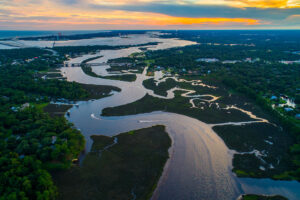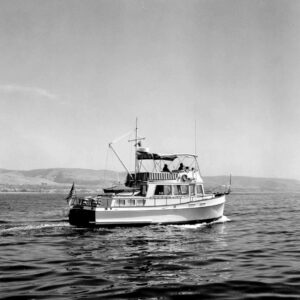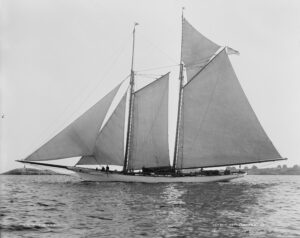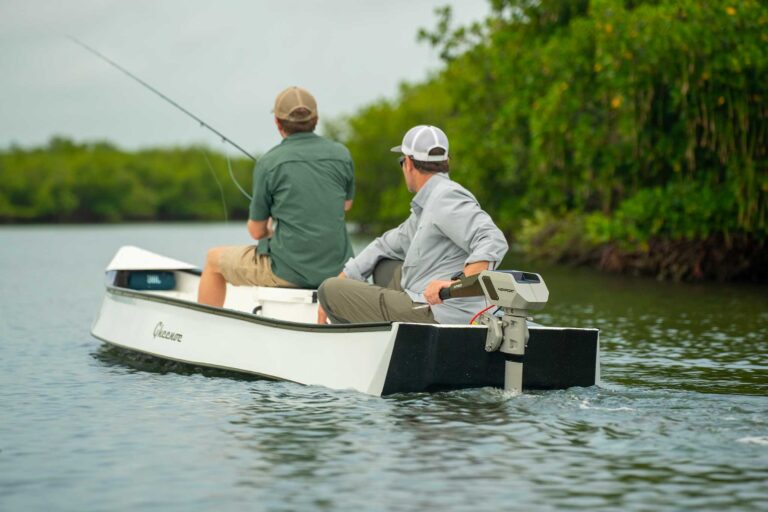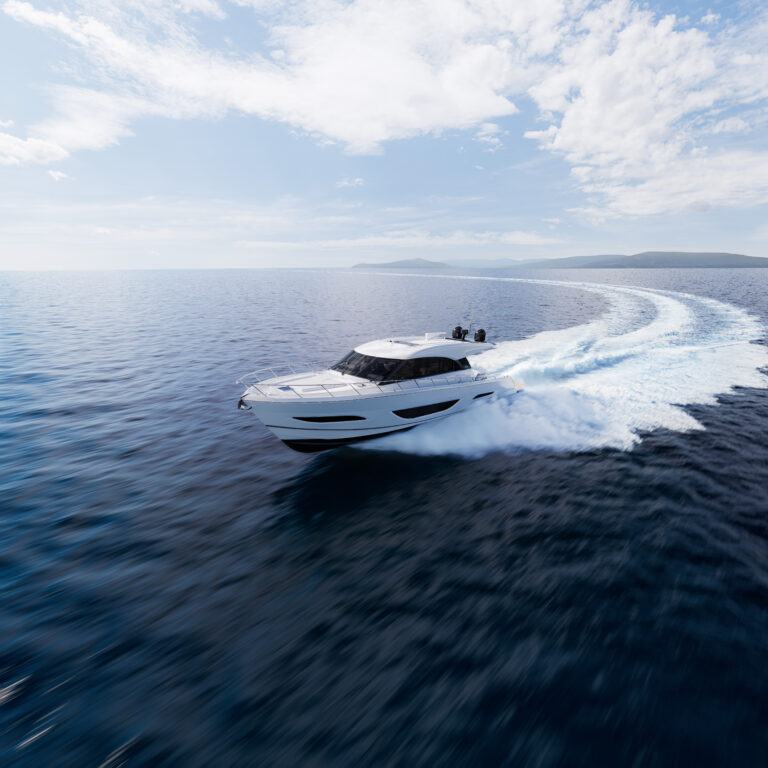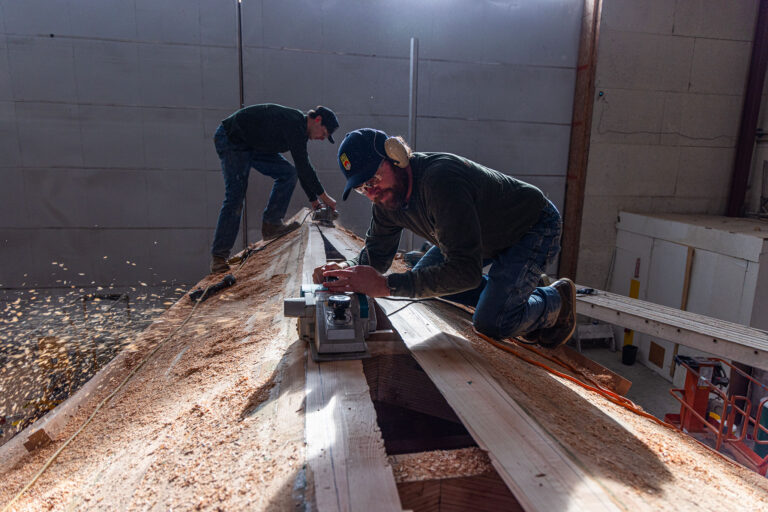Heeled onto her chine, a reef in the main and a bone in her teeth, Panope bore down on me. Drifting in a tiny plastic dink across Mystery Bay with no place to hide and no way to escape, I was headed for a date with perhaps the world’s most substantial 34-foot sloop, her massive bowsprit and two stout anchors. A tad disconcerting was the fact that the skipper was out of sight, lounging on the aft deck, hands free, while calmly watching his craft whooshing past me with a couple of feet to spare.
The drama felt real, but catastrophe was not in the script. Conditions and course hardly matter, Steve Goodwin—the owner, captain and caretaker of this remarkable craft—later explained. “Panope practically steers herself,” he said.

Goodwin’s not the bragging type; he speaks from decades of experience. There’s not a square inch inside or out on that boat he has not touched since he took over from his dad, back in the late 1990s, methodically refitting and modifying this vessel to suit his needs. The job is done, but it won’t be finished, ever. Listening to Goodwin talk about Panope and watching him sail her, it’s plain that to him, this is no burdensome chore. It’s more like therapy to keep the mind engaged and the hands busy.
Goodwin’s love affair with Panope dates back to the mid-1970s, when, as a boy, he watched his dad, Lynn, a now-retired marine biologist, tow an unfinished aluminum hull onto the family property in Quilcene, Washington, to finish it himself, installing a cozy oak-and-cedar interior, building a 6-spoke swooned steering wheel and rigging her as a passagemaking schooner so that one day he might get on the Blue Highway. Things didn’t quite pan out that way, but that’s part of the story.

“I knew nothing about sailing, but a friend persuaded me to buy a boat,” Lynn said with a laugh as we sat on his porch overlooking the northern reaches of Hood Canal. That boat is called a Saugeen Witch, a Thomas Colvin design that was popular with cruisers who wanted a sturdy and offshore-capable craft they could fit out to their tastes. At the Greenwich Yard in Vancouver, British Columbia, Lynn and his friend each plunked down $13,000 (about $71,000 now) for hulls number 12 and 12A (sailor’s superstition). “[My friend] said, ‘You don’t need an engine,’ but that was a mistake,” Lynn recalled. Operating a 7-ton boat in the fickle waters of the Pacific Northwest without an engine isn’t exactly practical, as Lynn found out when sailing on his friend’s boat, so he smartly added a 15-hp Yanmar diesel to his own.
It took Lynn six years to finish the boat, but in 1981 a house mover was called to haul it down to the beach where a rising tide gently floated Panope off that beach, so she could start her career as a family boat, faithfully carrying the Goodwins across local waters for fun that always included fishing, clamming, crabbing and shrimping.
An ocean-grown protein is the namesake of this boat, which was christened in honor of a large burrowing clam, panopea generosa. The choice is connected to Lynn’s work as a marine biologist. He made this once poorly understood mollusk the center of his research after he’d moved from Idaho to western Washington in the 1960s. Colloquially known as geoducks (pronounced gooeyducks), the oldest specimen known was dated at 179 years. Because of their long, 3-foot-plus siphons, they sometimes also are called elephant, trunk, king or penis clams.

Aside from a sabbatical cruise to Cabo San Lucas, Mexico, Panope never ventured far beyond local waters. After bashing into the northwesterlies for 900-odd miles on the way north, Lynn had his fill, pulled into San Diego Bay, hauled Panope and had her trucked home. He kept using her, but upkeep began to take a toll. So, in the late 1990s he ventured to put the boat on the market. But his younger son, Steve—who’d dropped out of college to construct his first house, to work as a boatbuilder at the Townsend Bay yard, and to take a crew job on a motoryacht he’d helped build—wanted to keep Panope in the family.
Although Goodwin had no formal education in the trades, he’d picked up essential skills at the different jobs he’d worked, becoming conversant in metal fabrication and welding, in carpentry and composite work, and in systems and electrical, which pretty much covers the job list he envisioned for Panope. He had the chops to take on the task, but, more important, he’d also learned from watching Lynn that a sound work ethic and persistence are good allies for monumental projects. “I do not recall my father verbalizing these sorts of teachings,” Steve said. “Instead, he taught by example.”

The details of Panope’s refit could easily fill a book. But Goodwin, who also produces a YouTube channel that details his anchor-testing regimen, has two videos that show the dazzling variety of jobs he took on while turning his father’s passagemaker into a cruiser.
The conversion required a repowering; he installed a bigger 40-hp diesel and a larger prop to buck a foul current if necessary. It also meant converting the schooner to a gaff sloop, which subtracted one mast, decreased clutter above and belowdecks, simplified handling and helped “reduce overall length,” as he explained on camera. That work cut docking fees, an important aspect for Goodwin’s thrifty disposition. By adding a tabernacle to the remaining mast, he can raise and lower the stick by himself with the help of a gin pole, instead of hiring a crane operator.
The addition of an aluminum deckhouse aft was another highly visible change, a big project he sketched in his head and executed with aplomb, without formal plans. The deckhouse seats six, is fully protected from the weather and offers a 360-degree view through 13 tempered-glass windows. Unlike some other retrofitted deckhouses, Panope’s has a dash of feng shui, an oak-and-cedar interior (a nod to dad), sound proportions and neat details, including a sun visor across the front to emphasize that Northwest workboat look.

On deck, there’s not a single piece of wood to be found, minimizing maintenance work. At the same time, many of the custom fittings Goodwin fabricated serve multiple purposes. The bowsprit moves the headsail tack forward, doubles as an anchoring platform and folds up in the marina. The single-arm davit on the aft deck holds the 8-foot Walker Bay dink (aka “photoboat”), carries lights and antennae, serves as crane, and pivots inboard to further shorten overall length. The old wooden foredeck hatch made way for an aluminum version that doubles as a bench seat. And a 5-foot, 6-inch-long beaching leg that attaches to the abandoned chainplates of the schooner’s mainmast keeps the boat near upright on a shallow beach when the tide is out. It’s all stout of course, as behooves a substantial aluminum cruiser.
The cabin is wide open nearly stem to stern, with only one bulkhead forward, hiding the new composting head. The other compartments—engine room under the deckhouse, the original galley at the foot of the companionway, the salon and the sleeping quarters with up to six berths—are separated by ring frames and half-bulkheads, a design choice that results in a large space with lots of stowage (including space for inflatable boats and stand-up paddleboards), but little privacy.

Also in short supply was headroom above the settees, courtesy of Panope’s low side decks. So, Steve moved the benches closer to centerline and made them higher. With the mast now farther forward, there was enough room, but a new salon table was required. Consulting with friends and designer Bob Perry, Goodwin settled on a substantial L-shaped pivoting aluminum pipe leg that easily holds the weight of an adult. He said it offers “an infinite number of positions and can be quickly de-mounted and affixed to the bulkhead.”
Underneath this table, in the depths of the bilge, hides Goodwin’s dirtiest job: re-ballasting the boat. He reduced weight and moved it forward and lower. Using terms like “very slow-going,” “backbreaking work,” “hunched over and dusty” and “just miserable,” Goodwin insinuated the labor was a test of will, endurance and personal limits. Of the 5,000 pounds he wanted to remove, he got out about half the cement and a third of the lead. “I tried everything—drills, saws, chisels. Nothing was very effective until I rented a real large jackhammer with a chisel bit. “
Using a makeshift hearth with an adjustable mold instead of a crucible, he melted the old lead into new shapes to fit the narrow bilge space forward. Climbing ladders up to the deck and down into the cabin with 95-pound ingots on his back was a hard-core workout. Then he set them into epoxy and fiberglass cloth to prevent cracking, and to isolate the lead from the aluminum hull. In the end, he had 1,600 pounds of lead trimmed, cut, ground and chiseled to fit the keel boxes. To finish, he welded cover plates “for a polished look” and to divert any water to a sump, from where it gets pumped overboard.
“The boat is now much better suited for gunkholing the waters of the Pacific Northwest,” Goodwin noted with satisfaction. There are trade-offs, of course, like curtailed space for seafood extraction on the aft deck, and increased windage from the new pilothouse. Both are concerns for Lynn, who otherwise approves of the changes. But it’s Steve’s boat now, and he likes it as is. “By abandoning offshore utility/safety, the boat [is] more comfortable for the Inside Passage’s cooler, wet weather,” he said. Panope, it should not go unmentioned, rarely missed a summer sailing season during the refit years.
It took Goodwin nearly a quarter century to remake the schooner into a cutter that suits his needs. He’ll never stop tweaking; he continues to schedule new work on Panope around other jobs while working as a systems specialist at Cape George Marine Works. Panope is not starved for attention, as Goodwin enjoys every minute with her, be it buzzing a guy in a dinghy or scheming what to do next.
“Overall I’m real pleased,” he said. “Things are a lot nicer on board the boat.”
Length on deck: 34’0”, LWL: 27’0”, Beam: 10’0”, Displ.: 15,000 lbs., Sail area upwind: 780 sq. ft., Motor: 40-hp Yanmar 3JH3E diesel
This article was originally published in the September 2023 issue.



